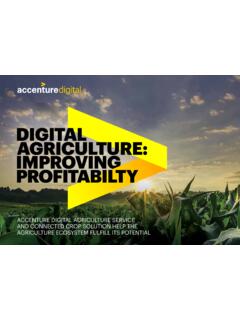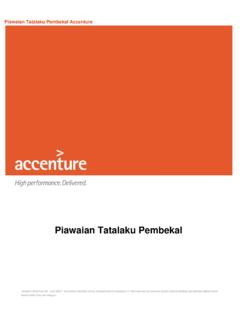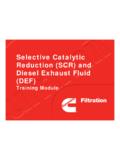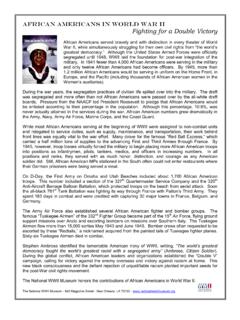Transcription of THE ELECTRIC VEHICLE - Accenture
1 THE ELECTRIC VEHICLE Why manufacturers need to rethink their ecosystems, the customer journey, and the entire value chainOriginal equipment manufacturers (OEMs) face growing pressure to address a dramatically shifting industry and customer landscape:SUSTAINABILITY NEEDS are growing and maturing, especially among young people, and particularly where mobility is CUSTOMERS who are living in urban areas and are more likely to use multi-modal urban transportation are inclined to use digital channels to stay updated on the latest technology CIRCULAR ECONOMY is pushing the automotive industry to make environmentally friendly vehicles along their whole lifecycle from green production using renewable energies to responsible battery disposal and chemical EVOLVING TECHNOLOGIES are reshaping the passenger VEHICLE through Connectivity, Autonomous, Sharing and Electrification (CASE) the e-revolution along, EVs are becoming increasingly sophisticated.
2 For example, Tesla Inc. pioneered the concept of selling wirelessly updatable vehicles, demonstrating that it is possible to transfer updates and new features to the VEHICLE much in the same way consumers download new software to their smartphones. Today other traditional automotive manufacturers are following EVs are clearly emerging largely as a result of global demand for greener mobility solutions. And over the next decade, battery-powered ELECTRIC vehicles (BEVs) will be more prominent and gain significant market share. How OEMs respond will steer the industry in new, unchartered directions, driven largely by new customers (and a new customer experience), an evolving value chain evolution and a new essential s next stop: ELECTRIC vehiclesThe mobility industry has been responding to a global demand for higher sustainability for many years.
3 The ELECTRIC VEHICLE (EV) is one answer. The acceleration toward EV production is shaking up the automotive industry in ways no one could have predicted. How manufacturers respond could mark an industry revolution not seen in ELECTRIC VEHICLE 2 Electrification is at the center of the mobility revolution Electrification is accelerating the mobility revolution, and is benefiting from connectivity, shared mobility and autonomous VEHICLE partnerships (see next page).Hyundai Motor Group In 2019, Hyundai launched the first rural carsharing service in Spain that uses 100% ELECTRIC technology. By using the Carsharing Rural VIVe de Hyundai mobile app which was developed specifically for this service users can manage their reservation, unlock the VEHICLE and locate the nearest charging station, thus highlighting an efficient solution for rural YOU KNOW?
4 By 2025, all new vehicles are expected to be connected, and by 2030, 30% will likely be electric3 58% of autonomous, light-duty VEHICLE retrofits and models are built over an ELECTRIC powertrain4 45% of car-sharing providers in Europe already operate a 100% ELECTRIC fleet5 While e-mobility is a huge game-changer, electrification is not the only factor shaking up the automotive industry. Together, CASE megatrends are revolutionizing the mobility status quo. The ELECTRIC VEHICLE 3 Address customer concerns providing the possibility to try EVs using sharing services Facilitate fleet management sharing, reducing maintenance needs and enabling higher VEHICLE availability Reduced emissions encourages municipalities to push ELECTRIC sharing fleets VEHICLE re-design for electrification facilitates connectivity technology adoption Remote control over EVs status and remote management Grid connection with related charging services Range extension thanks to efficient VEHICLE management but higher computing power has impacts on the battery Higher VEHICLE availability due to autonomous management of charging and maintenance activities VEHICLE development for electrification & EV features ( fewer moving parts)
5 Facilitates autonomous technology adoption Technology-focused adopters want both autonomous and electrification innovationsELECTRIFICATIONAUTONOMOUSCONN ECTIVITYSHARINGM egatrends shaping the mobility revolutionThe ELECTRIC VEHICLE 4A new energy tank that redefines the VEHICLE : COSTS: The battery represents a single component worth up to 35% of the VEHICLE s total value PERFORMANCE: Affects mileage range, charging time and engine power EVOLUTION: No longer just a standalone VEHICLE but an active part of the grid enabling effective energy management ( VEHICLE -to-grid or VEHICLE -to-home solutions)New materials driving a new supply chain: New suppliers and battery manufacturers become essential partners for EV development New raw materials lithium, cobalt, nickel and other materials sourced from alternative countries, such as Democratic Republic of Congo and China, creating potential geopolitical and ethical issues A new re-fuel concept driving a new customer experience: From refueling to re-charging From gas station to charging station or home charging From VEHICLE to integrated device, collaborating and exchanging energy with future smart home and citiesA component with a second life: Disposed batteries are becoming new energy storage packs enabling renewable energy sources for peak management, opening to new services (such as battery pack rental solutions) or to be used as new batteries for lower performing vehicles The battery.
6 At the heart of the revolutionEVs depend in large part on battery power, which changes several components of the traditional OEM ELECTRIC VEHICLE 5 Electrification at a glanceElectrification involves a lighter powertrain with a new energy tank (high voltage batteries), and an increasing emphasis on software. These changes to the VEHICLE accelerate the need for a new e-customer journey. Specifically, EV drivers will have a very different charging experience that completely upends the concept of refueling. For example, an EV takes much longer to charge than a simple three-minute fill-up at the traditional gas pump. Companies are already responding to this development. Volkswagen, for example, offers a new platform specifically for EVs the Modular ELECTRIC Drive ChryslerFiat Chrysler Automobiles is making buying an EV easier by offering at-home charging stations on popular consumer websites and including installation services for any branded EV COVID-19 EFFECTS The COVID-19 global pandemic, which introduced social distancing and other major lifestyle changes, redefined mobility.
7 A global lockdown affected every aspect of the automotive sector from parts suppliers to the push toward VEHICLE electrification continues unabated COVID-19 will not stop the revolution. In fact, the number of EVs on the road is expected to reach almost 10 million this year, as sales grow despite the And amid the crisis, EV sales could reach a record share of the overall VEHICLE market this While converging forces affected its speed differently by region, the e-revolution nevertheless will drive to more sustainable YOU KNOW? Driven by stringent CO2 emissions targets, European governments and automotive players in 2019 committed to 60 billion in investments to produce EVs and batteries times higher than in The ELECTRIC VEHICLE 6 The law of threesThree motivating forces are pushing OEMs toward the EV market E-mobility is leading to a radical change of three key automotive elementsThree geographies are leading the e-mobility trend Government regulations and incentivesMore stringent CO2 emission regulations are dovetailing with incentives and subsidies that support EV investment, promotion and a new e-value chainThe standard value chain needs to evolve to deal with a new EV, not only from the engineering and manufacturing side, but also from the user perspective.
8 It should include new suppliers and meet new customer needs and expectations. ChinaThe Chinese government is driving mobility electrification with significant investments in infrastructure, supply chain development and purchase incentives, making China the biggest EV market in the and technology developmentWidespread availability of charging stations and technological enhancements (such as higher battery capacity) will all but guarantee VEHICLE usability and increase customer a new customer experience (for new customers) A new customer experience is evolving based on charging time and needs. Customers are more attentive to the impact on the environment and the use of renewable energy and is increasing efforts toward more sustainable mobility, multiplying investments in both EV production (led by German VEHICLE manufacturers) and battery supply chain development (European Battery Alliance) and penalizing OEMs exceeding emissions e-readinessConsumer awareness of the direct impact their choices and behavior have on the environment are increasingly advancing e-mobility.
9 Discovering a new ecosystemNew players are gaining prominence as they disrupt the long-held automotive status quo. To be successful in this market, these new competitors are investing in developing a robust EV ecosystem and charging the , many states are investing in EVs and adopting stronger regulations, targeting more sustainable mobility and emissions ELECTRIC VEHICLE 7 Manufacturers face three additional hurdlesTraditional OEMs are facing new challenges related not only to a new product, but also to emerging customer expectations and skepticism toward EVs (see next page). They must address three main issues to reach the mass market:1. VEHICLE profitabilityHigh investments which are required for EV development and production significantly impact OEMs profitability. This is at a time when sales volumes are still limited and purchasing prices must be contained to make EVs affordable and appealing to customers.
10 2. VEHICLE usabilityCustomers concerns about EVs range and limited charging options remain despite major improvements in technology and infrastructure. 3. Environmental sustainabilityEVs total sustainability is a significant challenge, forcing OEMs and all players to focus on vehicles entire lifecycle not only tank-to-wheel but well-to-wheel emission new essential ecosystem is emergingThe ELECTRIC revolution creates a new, evolving ecosystem that includes utilities, charging infrastructure developers, new mobility service providers and battery manufacturers, to name a few important categories. OEMs will have to work with new players and orchestrate the ecosystem to develop a consistent offering of vehicles, services and charging example, Daimler has created a live replacement parts store for the fleet of third-generation EVs.
















